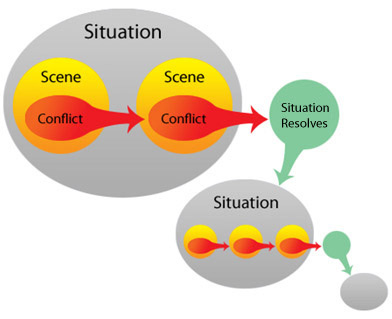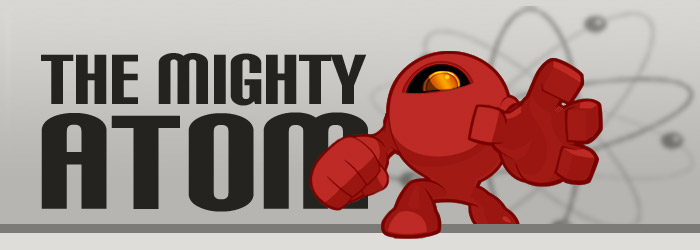Situation, Scene, Conflict, Resolution
Sunday, January 01, 2006

Vincent, Ron, Clinton, Matt, and others have explained this idea in various ways before, but making this diagram helped me figure it out in a very concrete, practical way. A similar diagram is going in Stranger Things.
The idea is that first you establish Situation. This is the immediate situation that the character finds herself in, which also contains the larger conflict ("The vampires of Fog Alley are killing important nobles of the city."). This situation is addressed through a series of several scenes. Each scene is embedded in the situation and a conflict is embedded in each scene. By resolving the scene-level conflict, you move to the next scene within the situation. After several scene/conflicts, you resolve the current situation, which in turn moves you to the next situation. Repeat. And that's a way to roleplay.
Once I had this diagram, I was able to see all the parts, and begin assigning authority and game tasks to each part. Who says what the Situation is? How does a Scene relate to Situation? Who says when a Scene begins and ends? Who says when a conflict begins and ends? How do you know when a situation is "resolved" and how does that resolution supply material for the new Situation? All that kind of stuff.
Once you add Flags, this diagram makes it possible to draw a roadmap for a game session that a GM can actually use in play without "railroading" or employing Force to steer the events toward set outcomes.
This is remedial stuff as far as theory is concerned (it's a rehash of Dogs town creation, really), but making the diagram made it really click for me so I thought it was worth sharing. The key for me was in recognizing that all of those circles above are not just "things that happen" during a game session, but that they are game play modules that need to be assigned ownership and authority. And that it's possible to write clear, repeatable methods for creating good material for the circles during play.
UPDATE: Some people got the idea that by making this diagram, I was claiming to have invented basic plot structure from Lit Theory 101. Of course, that's not the case. This diagram (and the one that follows it in the next post, above) is simple description of game elements as observed in play, nothing more. It's not supposed to be new or revolutionary. It is in fact "remedial" -- which is what I say in the post.
The point of this post is not the formation of the diagram (which could have easily have come from any Lit textbook) but rather how a game system distributes authority over the elements. I hope this update makes that crystal clear, and we can continue our useful discussion about those authority issues.
Labels: rpg theory













11 Comments:
Great diagram! Very useful.
Nifty!
Like bankuei said, nice for visual thinkers. And I'm one of those that doesn't get the theory very well, so I can witness to his latter statement as well. Are there any parts of that kind of play (which might not be rewarding, I dunno) that fall outside of that cycle? (Other than things that almost always fall 'outside of play' like bringing food) Scenes that are tied to Situation but don't end up in Conflict?
I think in this case "scene" isn't referring to a specific time and place where characters are doing stuff. It's referring to an event or multiple events that lead up to a conflict.
So in that case, there's going to be plenty of action that involves information gathering, exposition, that sort of thing, all pointing toward some kind of conflict.
Matt's right: 'Scene' is a flexible term. It's one of the things that needs to be defined and given ownership in the game design. Is a scene a specific time and place (determined by whom?) or is it a series of events? Either way, conflict is embedded within it.
For Stranger Things, a scene is a specific time and place, determined by the Director, using flags created by one or more players. The game works this way because the idea is to play only the moments of crisis and change in the Stranger's life, not the 'in between' stuff.
PTA works in a similar fashion. TSOY, on the other hand, doesn't demand strict scene definition and lets conflicts arise organically from the back-and-forth between GM and players. But once conflict begins, stakes are set, and the parameters of the conflict are solidly embedded in the scene and situation with clear markers to show how the current situation will change as a result of the conflict.
Contrast with Savage Worlds (a game I love, by the way). As written the conflict system (there's only one: combat) can be invoked by one participant only and its outcome (is the enemy dead or not?) is not necessarily embedded in the scene and will not necessarily move the situation towards resolution. The game doesn't offer a system for resolving one situation into another -- which is the thing that is starting to look like the fundamental activity of gaming, to me.
Imagine a game in which each participant is holding this diagram during play, and it's everyone's job to use it to structure the game.
"So, wait, what's the Situation and how does this Scene relate to it? Are we aiming towards a conflict here?"
and
"Last week, you teleported away with the Dragon's horde. It's safely locked away in your vaults in the Tower of Mists. That situation is resolved. You're all very rich. However, the Dragon is not without resources and powerful friends. He is not going to let this theft go unpunished."
Stuff like that. They're signposts for game play. Little things that say, we did that, it's done, now we are doing this.
Heya,
This is somewhat tangental to what you posted, but could you explain to me (in really plain english cause I'm sometime slow) what in the heck "Flags" are?
Peace,
-Troy
Chris: That sounds cool. I hope you'll post more about this game when it's ready.
Ben: Don't make me shake you.
Yeah, I see how that's confusing, Joshua. Maybe I need to tweak the terms in the diagram.
The teal "Resolution" refers to the the resolution of the Situation, not the "resolution system." System is always engaged across all the circles.
I tweaked the graphic to clarify the "resolution" thing.
I'm also doing another diagram of my traditional RPG play (pre indie game revolution) to contrast the two styles.
For us *really* visual thinkers, it would be really useful to see a "filled-out" version of this diagram. You know, with the vampires-of-Fog-Alley bit in the big circle, and samples (or tags for them, as will fit) in the smaller ones.
Fred: Of course you're right. This is a diagram of ONE situation in play. There can be any number going at once. I don't think I implied otherwise, but it's good to point it out.
Karen: Great idea. I'm away from home traveling now, but I'll put together a full diagram like that when I get back.
Post a Comment
<< Home